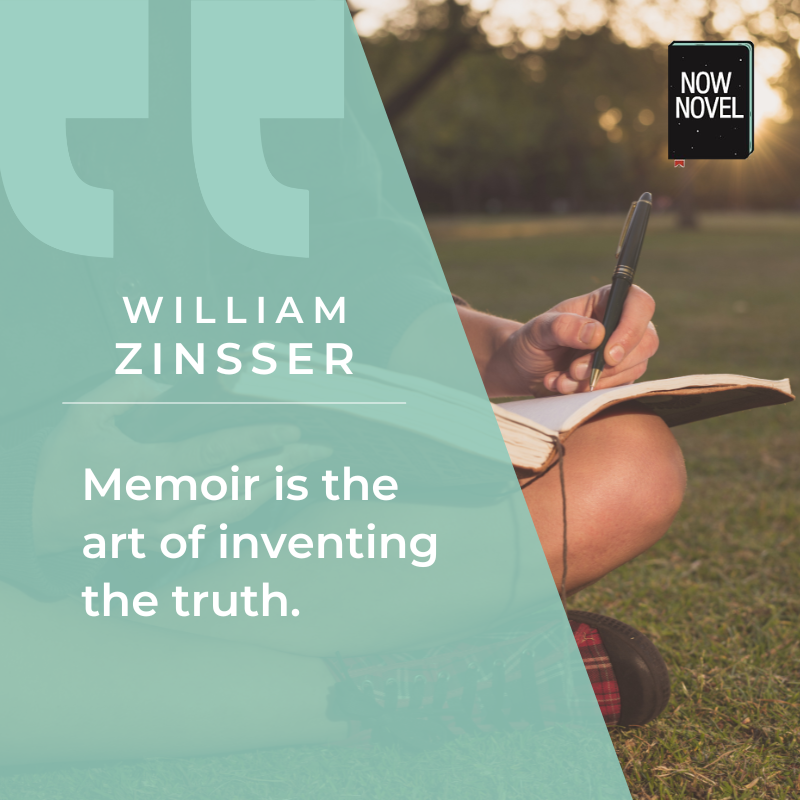Knowing how to start writing a memoir is important if you want to write autobiographical books that hook readers. From humorists like David Sedaris to more serious memoirists, the best memoir writers know how to treat their personal stories with the creativity of a fiction author.
10 tips to start writing a memoir
- Know your field: Understand the ingredients of great memoirs
- Privilege story over your personal experience
- Choose what to leave in your memoir and what to cut carefully
- Begin with the most engrossing, dramatic part
- Show more, tell less
- Do just tell where showing could make your memoir drag
- Use details to make your memoir more imaginative
- Forget family censors
- Employ fiction's most useful elements
- Separate 'therapeutic writing' from 'therapy'
Let's examine each of the above points in more detail:
1: Know your field: Understand the ingredients of great memoirs
Like fiction genres, memoir has its own set of conventions and elements that many readers expect. For example, most memoirs are written in the first person, using 'I'.
This isn't necessarily a 'rule', though. Famous authors have written memoirs in the third person. The social theorist and linguist Roland Barthes wrote his memoir Roland Barthes by Roland Barthes in the third person, referring to himself and his history using 'he' throughout. The preface to the memoir reads 'All this must be considered as if spoken by a character in a novel'.
Something Barthes acknowledges in this is that the person doing the writing now is not necessarily the same person who was the child or student. Your younger self might very well feel almost like a character. The device itself allows the writer to play with the conventions of autobiographical writing and be more experimental with form - much of the book is written in short, fragmented paragraphs, like snatches of memory that return and recombine.
Annie Ernaux does something similar to Barthes in her novel, A Girl’s Story. Note that although it is labelled a novel, it uses the facts of Ernaux’s life as well as her real name.
Whether you adopt a creative or more traditional approach to your memoir, know some of the landmark memoirs and what makes them great. Michel de Montaigne, who lived during the French renaissance, is one of the first writers who paired autobiography with creativity and insight, and his essay-like memoirs written during the 1500s are still read. Montaigne combines his own experiences with shrewd observations about his contemporary society. The 19th century philosopher Henry David Thoreau's book of memoirs, Walden, is another classic of the genre. Read highly-regarded memoirs for insights into the many ways to tell your own true story.
In writing memoir, it's essential that you place the story, the sense of eventful incident, first:
2: Focus more on story than your own subjective experience
One of the mistakes first-time memoirists make is to focus almost exclusively on describing their own subjective experience. Even though memoir is about your own impressions and insights, it's important to convey this information in a way that readers are able to enjoy the universal elements within your own personal experience.
Example: You write about a holiday spent in a cabin in the woods. You could describe how glad you were to get away from the city and your feelings about the cabin, but look for the items that readers will find most relatable. If there is adversity (car breakdowns, finding the cabin in a terrible state or other dramatic incidents), make these the focus. Readers will likely bore of a blow-by-blow breakdown of daily activities that don't have a sense of story - laughter, insight or a purposeful sense of cause and effect.
The way to make sure your memoir doesn't bore readers or make them say 'so what?' is to be careful about what you include in your autobiographical writing and what you leave out:
Subscribe to our newsletter
One million authors use our writing resources to get their books published. Come join them.
3: Choose what to leave in your memoir and what to cut carefully
As Adair Lara notes in an article on writing memoir, a good memoir needs extensive cuts so that there are no extraneous facts or overemphasized details:
'Do you see events that need cutting? Once we get that your ex is a swine, there’s no need for the six scenes of additional evidence.'
When you're deciding what to include in your memoir, ask:
- How does this fit into the main themes of my memoir (e.g. Overcoming personal obstacles or self-destructive behaviour). Does it illustrate something important?
- Have I already addressed this point elsewhere in the book?
- Is this likely to connect emotionally with my average reader?
As you would when writing a fiction book, make sure that every scene in your memoir builds to a climax or important point. If writing a memoir of overcoming addiction, for example, try not to write extensively about how you frequent public libraries unless this somehow fits into and enriches the anecdote or story.
4: Begin with point of highest drama
Readers get impatient quickly with memoirs that plod through loads of backstory to get to the 'juicy' parts. Begin your memoir with an incident that is uncommon in its dramatic or humourous content. Even if this means beginning in the middle of the story, you can retell events out of chronological order. Begin with the major turning point and cycle back to explain how you came to that point later (or simply progress from this point to the resolution).
As Roberta Temes notes in her article on writing memoir for the Huffington Post, memoirs are different from autobiographies in how they begin and in the kind of content they include:
'Autobiographies are linear stories that start at your birth and continue until present day. Memoirs, on the other hand, cover only certain aspects of your life. You may write a memoir about your career as a model, your relationship with your Aunt Maggie, your trip to Madagascar, or your new-found religion, or even your pet monkey.'
Begin your story where things get real, where readers are most likely to find something they can connect with and relate to, be it a hardship, a discovery, a turnaround, a colossal loss or gain.

Bring your publishing dreams to life
The world's best editors, designers, and marketers are on Reedsy. Come meet them.
5: Show more, tell less
Even though this advice is over-used (sometimes telling is necessary), in memoir you have to balance simply recalling events with reworking them so that you put the reader in the scene. If you focus too much on your own emotional experience without putting it in accessible terms, you risk standing in the way of the reader's emotional experience.
If, for example, you were to write about complex family dynamics, if you wrote 'I felt betrayed and abandoned, and I didn't know how we would heal the rift' this has a degree of affect (the power to bring forth emotions in the reader). Yet if you show this feeling in actions and dialogue (even if you have to make up parts of what you can't remember word for word), your memoir will feel more vivid to the reader. It enables the reader to put themselves in your shoes.
6: Do just tell where showing could make the story drag
Just because you want the reader to get the whole story doesn't mean you have to show every incident in your memoir in minute detail. This is where the 'show, don't tell' advice wears thin. If you need to fill the reader in on what happened in the years between two significant events, you can simply tell them in two or three lines.
So long as you balance showing with telling, your memoir will read well. Think of the memoir as a colouring-in book: The telling creates the black lines, but the showing is the colouring in that brings the flat shape of the story, the idea, to life.
7: Use details to make your memoir more imaginative
In fiction, it's the details that let us recreate a setting or a time period in our mind's eye. If you can't remember particular details - the lie of your childhood home or the exact words of a pivotal conversation - it's fine to make up details that won't cause any grievous offence to real people who star in your story.
It's important too, to not let real living family and friends' opinions censor your memoir too much:
Subscribe to our newsletter
One million authors use our writing resources to get their books published. Come join them.
8: How to start writing a memoir freely: Forget family censors
Many authors have written memoirs using the real people in their lives as their cast of characters. There will be people who are upset by your 'using' them as story material. There are ways to avoid causing embarrassment and upset, however:
- Use just the initial for people's names. Instead of 'Peter' write 'P' - this protects the person's identity more, especially if the person's relation to you isn't specified
- Change names: The facts of a story and the way you retell them are important, the true names of characters aren't
- Run the story past real people mentioned if your memoir will be published: This will help to avoid any fallout
9: Use fiction-writing devices in your memoir
Like fiction, memoir should draw on creative devices to keep readers' focus and interest. Even though it's a true story, a memoir should have a palpable sense of plot: 'Y happened because X happened before. Z though, was completely unexpected'.
Consider incorporating these elements of great fiction in your memoir:
- A protagonist (usually yourself, but you can write memoir where other figures in your life feature as the main 'character')
- An antagonist (someone who was an adversary or rival, whose opposition you had to overcome)
- A conflict: The best memoir describes events that have inherent dramatic power (such as how the author overcome a major life change or challenge)
- Setting and mood: Think about how readers will see the real-world setting you describe, and consciously decide on the mood you want to evoke. Will your memoir be sweetly wry and self-deprecating or powerful and bleak yet true?

10: Separate 'therapeutic writing' from 'therapy'
Many aspiring memoirists describe the therapeutic benefits of writing memoir as a primary motivation for writing this particular type of book. Put simply, telling our truths helps us - we process trying experiences and generally learn about ourselves in the process.
Bronwyn Hemus at Standout Books makes an excellent point: There is a difference between 'therapeutic writing' (writing that has a nurturing or healing effect on the author) and 'therapy' (writing that indulges the author's emotional life first, putting the reader's experience second. Says Hemus:
'Writing memoir is a highly personal and “self” orientated experience. While you do not need to be an established, published or experienced writer to begin writing your memoir, if you are writing to publish, it’s easy to lose sight of the purpose of writing, and to forget that you are – above all – writing for a specific audience and not just yourself.'
Remember this and work at striking a balance between your personal story and what it means to you and making your story mean something to others.
Start sharing extracts from your memoir for helpful feedback on Now Novel.










I’ve completed my memoirs and wanted to share my experience. I decided at the outset to write first and edit later. Over the winter of 2012 penned ninety thousand words. I focussed on particular aspects of my life then used them as building blocks to create a story wall. Writing wasn’t difficult. Although proud of my achievement I knew the real work had yet to be done. In essence my wall though colourful was little more than graffiti. To turn it into a masterpiece I’d have to roll my sleeves up and edit (starting with clichés). Over the summer I ignored my graffiti wall and played my guitar. Winter arrived, my fingers worn to the bone (six months solid guitar playing can be debilitating, if you don’t stop to eat, drink or sleep). I looked at my wall and the experience wasn’t as satisfying as it had been the previous winter. Although a mess I could work to improve its structure. My memoir written, I checked online to find out how to write one. I’m pleased I didn’t do that before typing my first word because there was lots of info available. Too much in fact, much of it conflicting, enough to put me off writing, if I’d bothered to learn, ‘how it should be done’. That said I found lots of good tips and advice that proved invaluable in helping me sculpture my graffiti wall. The bricks benefited from being shaped with my new tools after chipping away twenty thousand words, over used phrases and clichés. It was hard graft and not always easy to motivate myself but I persevered. The daily toil with wind, snow and hailstones conspired to persuade me to abandon my wall and leave it to crumble and wash away. I’d worked hard and wasn’t willing to give up without a fight. I didn’t want to hear my friends say “Have you finished writing your book yet?” That’s not true; I just thought I needed a bit of dialogue at this point. The tools I’d acquired were free and I’d taken more than needed. I utilised all available, with disastrous consequences. “My wall, my wall, I’ve ruined my wall” I cried, but fortune was on my side. Spring arrived to save the day. The tips of my fingers healed enough for me to pick up my guitar. I abandoned my wall to enjoy another summer of composing a lament to a lost memoir. As much as I’d have liked to stretch out the summer, I live in England and winter arrived early (it always does). I made good the damage I’d caused to my wall by repairing some of the bricks. It no longer resembles graffiti but would benefit from a craftsman’s touch. The moral Just write it! Don’t learn how to write, learn how to edit.
Jr Smith - Almost 12 years ago
Thanks for sharing JR, you're right, writing is the first part of the challenge.
Brendanmc - Almost 12 years ago
Thanks for this insight.I am working on my memoir about my school days as these are some of the most exciting and memorable times in my life.
Ohita Afeisume - Over 9 years ago
It's a pleasure, Ohita! I'd love to read about it.
Bridget At Now Novel - Over 9 years ago
I'm writing a memoir about all my trials and experiences. Explain my thoughts during that time, how I coped and survived, and how I moved on. I'm also including a reference section detailing different healing methods that have helped me along my journey. I'm calling it "A Woman's Journey To Healing" I'm hoping this memoir will empower others and help them through their trials and experiences and let them know they are not alone and it is possible to heal and move forward and that there is help out there as well. I'm also going to set up a separate email in case any of my readers wish to communicate with my directly. (Its going to be a very emotional book and very detailed. I'm hoping that writing it out will also help me heal more too). Thanks for insights, these will help me out immensely.
Cassie Jane Ripley - Almost 8 years ago
This is a useful and excellent share. Will definitely share it with people I know. I hope you can take the time to read my post as well The Excellent Benefits of Reading Memoirs
Byron - About 5 years ago
‘How to Start Writing a Memoir: 10 Secrets’ is a beacon for aspiring memoirists, offering not just guidance but a treasure trove of insights to unlock the doors of personal storytelling. Your thoughtful approach to distilling the art of memoir writing into ten secrets is both accessible and inspiring. It's evident that your expertise and passion for the craft shine through, providing a roadmap that empowers writers to embark on their memoir journey with confidence. This title not only promises valuable secrets but also reflects your commitment to demystifying the initial steps of memoir writing. Here's to unlocking the secrets and unveiling the rich narratives that await!
Cynthia - About 2 years ago
Hello Cynthia, thanks so much for taking the time to add your comments. I'm so pleased that you found it useful! Are you writing a memoir? Good luck with it, if so. Thanks for reading the blog.
Arja Salafranca - About 2 years ago